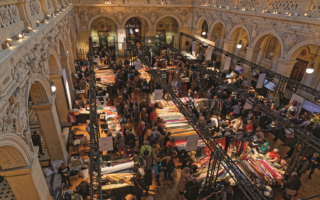Carving a career with soap vignette
In her regular series, Carol Drinkwater meets a sculptor using everyday materials
Buried in the back streets of Paris, behind the towering Colonne de Juillet in Place de la Bastille, is the untidy, unassuming studio of Sylvain Gaudenzi. Sylvain, a Frenchman of Italian descent and married to an Italian, is an art teacher and sculptor with a difference. He sculpts, not with stone, metal, ceramics or any of the matériaux nobles (an expression he uses regularly), but with soap, bits of reclaimed wood and food. He has worked in this same cramped atelier since the age of 17, when he was apprenticed to an Argentinian sculptor who occupied this space until Sylvain inherited it.
The 11th arrondissment, where he works, was famous for its furniture-makers. From the 18th to the 20th centuries, the passageways between Bastille and Nation were flanked by ateliers set cheek by jowl, each occupied by a craftsman. Anyone could stroll by and watch them at work. Sylvain recounts that it was once possible to walk between the two great places using only these narrow passageways and never passing by the main streets.
Many have been closed off now, but some still exist and it remains a district where artists and craftsmen continue to ply their trades. With the crepuscular, almost secret aspects of these alleys and their access from one part of town to another, it is easy to see how the French Revolution really got under way in this part of the capital; messages were passed, meetings arranged clandestinely in these hidden corridors.
It was Sylvain’s aunt who brought him here. He was a dyslexic, rebellious boy who refused to learn. At the college opposite his school, students were studying design. He liked them and, for want of a better response to his family’s never-ending questions, he said he would become an artist.
During the years that Sylvain was an apprentice in the early 1980s, traditions within the art world were changing rapidly. Picasso had created a sculpture out of old bits of bicyles, for example and Sylvain chose domestic, rejected materials. I asked him about his soap artwork. “It must be used soap, never new.”
He rubs the used sliver of soap between the palms of his hands until it begins to gain the consistency of ivory or bone. Then he cuts into it, carving out its design – he never knows in advance what the results will be. Afterwards, he paints the drawing with a mixture of oil and black ink. The result is delicate – black lines against pale tones, like an exquisite engraving. Before any piece is offered for sale, it needs a frame. Sometimes it takes months for Sylvain to find the ideal piece of wood or plaster to house the tiny object, which is protected beneath glass.
In total, he has created fewer than 400 of his soap oeuvres. They take time.
Most of his evenings are dedicated to teaching young children; and for five years he worked with patients in a mental hospital. He aims to unlock the creativity in his students. He is passionate about this work and recalls his own childhood locked within his dyslexia. Before I leave, he leaps to his feet and produces half a dozen black-ink drawings, painted on what I take to be parchment. “No, not parchment,” he grins, enjoying the game.
I take one of the miniatures between my fingers and study it. It measures approximately three inches by two inches. I turn it over. The unpainted reverse is opaque and certainly looks like parchment. His face is gleeful.
“Think again.” I cannot. “Lasagne,” he cries triumphantly. “Dried strips of lasagne. You see, I am celebrating my Italian heritage.”
Share to: Facebook Twitter LinkedIn Email


